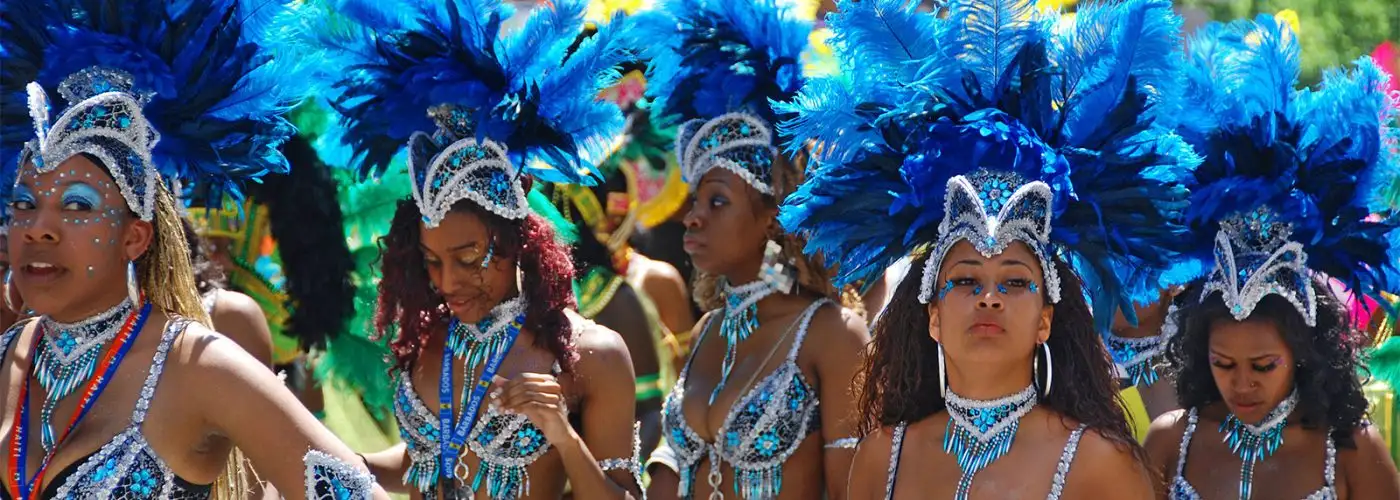It’s carnival season! For a warm, sunny place to unshackle your inhibitions, hit the Caribbean, where celebrations give you permission to indulge today and repent tomorrow. Read on to find out where you can see skimpy rhinestone-studded costumes in grand parades, cover yourself in mud or chocolate for pre-dawn parties, and take to the streets for jumping and gyrating to frenzied soca beats.
Image Gallery
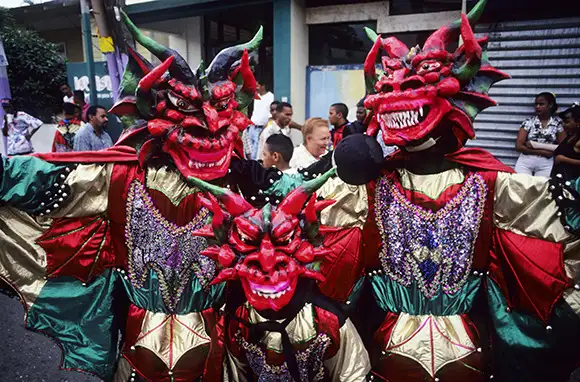
Dominican Republic
Colorful and frightening masks take center stage at carnival celebrations throughout the Dominican Republic. La Vega Carnival, the country's oldest and most renowned carnival, has fueled an entire mask-making industry in town. Here, the main carnival character is the unmistakable diablo cojuelo, or "limping devil." During Sunday afternoon street parades in February, revelers dress as the diablo cojuelo, carrying inflated animal bladders as weapons and playfully cracking whips as they mock the devil. Their huge masks with bulging eyes, horns, and menacing fangs are adorned in rhinestones and feathers.
When: Throughout February
If You Go: Carnival weekends in February are filled with parades and events in La Vega, Santiago, Santo Domingo, and Bonao. Festivities generally peak around February 27, on Independence Day.

Dominican Republic
Colorful and frightening masks take center stage at carnival celebrations throughout the Dominican Republic. La Vega Carnival, the country's oldest and most renowned carnival, has fueled an entire mask-making industry in town. Here, the main carnival character is the unmistakable diablo cojuelo, or "limping devil." During Sunday afternoon street parades in February, revelers dress as the diablo cojuelo, carrying inflated animal bladders as weapons and playfully cracking whips as they mock the devil. Their huge masks with bulging eyes, horns, and menacing fangs are adorned in rhinestones and feathers.
When: Throughout February
If You Go: Carnival weekends in February are filled with parades and events in La Vega, Santiago, Santo Domingo, and Bonao. Festivities generally peak around February 27, on Independence Day.
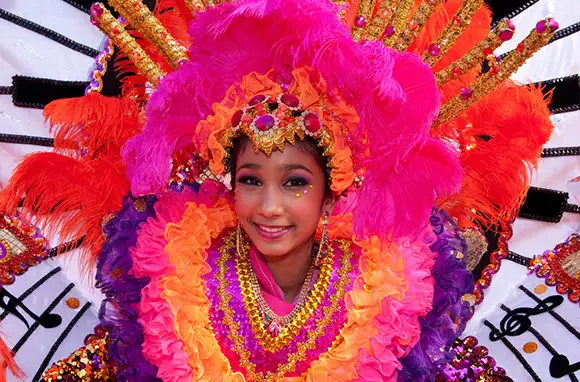
Trinidad and Tobago
Without question, the Trinidad Carnival is the granddaddy of all Caribbean carnivals. This celebration, packed into the two days before Ash Wednesday, draws 800,000 people to the streets of the capital city, Port of Spain. Here, anyone can buy a costume and join the scantily clad, gyrating masses. Monday's festivities begin before dawn, when partiers cover themselves in grease, paint, chocolate, or mud and dance through the streets until the sun rises. After a wash, they return in colorful costumes for more "jumping up" to soca and calypso pulsing from speakers stacked on music trucks with DJs. The real spectacle is Carnival Tuesday, when parading locals and visitors join with their themed masquerade groups to bump, grind, and flaunt outrageous glittery, feathery costumes past the judges and TV cameras.
When: February 16–17, 2015
If You Go: Listen for steel-drum bands praticing throughout the island in January and February in preparation for Panorama, the competition that determines which bands will play during the carnival.
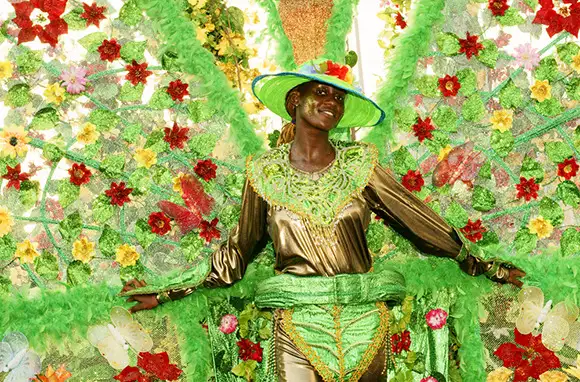
St. Vincent and the Grenadines
This carnival, affectionately called Vincy Mas ("mas" is short for masquerade), used to happen during Lent. But in 1977, the organizers shifted it to summer, so it wouldn't compete with the more popular Trinidad and Tobago carnival. Since then, islanders from throughout the Caribbean have flocked to St. Vincent and the Grenadines in June and July for a second helping of carnival carousing. The celebration here is large, with the usual street parties, costume parades, and fantastic calypso and steel-pan performances. One of the most popular events is the Soca Monarch Competition, when soca artists, pitted against one another, vie for the prize as they whip the crowd into a dancing frenzy.
When: June 26–July 7, 2015
If You Go: Bring the kids. Several events are geared toward children: the Junior Carnival masquerade, Junior Calypso, Junior Soca Monarch, and Junior Pan Fest.
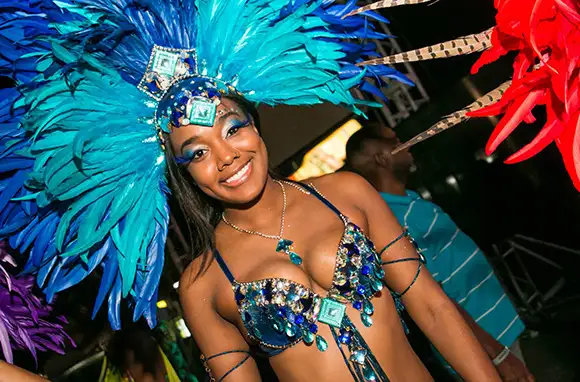
Jamaica
Relatively new to the carnival circuit, Jamaica debuted its own celebration in 1989, when a group of carnival-loving Jamaicans who traveled to the Trinidad festivities every year decided to bring the party home. You'll see Trinidad influences in Bacchanal, Jamaica's carnival, with similar pre-dawn J'ouvert parties (with participants covered in chocolate or mud) and a grand costume-parade finale through the streets of Kingston. Jamaicans "jump up" every Friday night in March, as popular visiting Trinidad bands play and the Caribbean's top DJs blare a fusion of reggae and soca. This is where partiers learn the music of the year and start the process of letting go. Here, you can also peruse the bejeweled, feathered, and barely-there Bacchanal costumes, which sell for $300 to $400.
When: February 20–April 12, 2015
If You Go: On Mondays and Wednesdays throughout March, join in the carnival's "Socacize" classes, when locals get their bodies in shape for the Road March costume-parade finale.
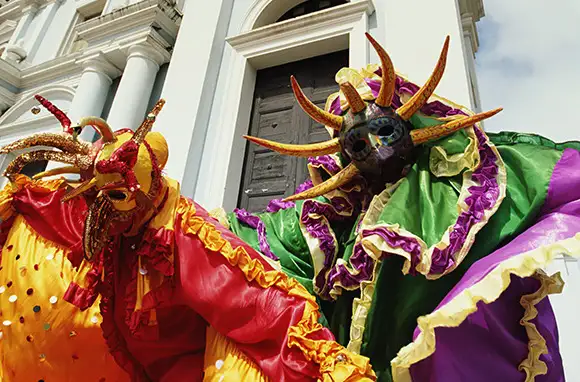
Puerto Rico
For a carnival experience where you get to take in the celebration's Caribbean flavor without the need for a passport or currency exchange, Puerto Rico is the place. In the city of Ponce, Carnaval Ponceño is a huge weeklong party filled with several street parades. The highlight is the massive two- to three-hour-long Grand Parade on the last day. Amid the dancing and merrymaking in the parade, you'll see the tradition of the vejigante, a folkloric character who shows up in several Puerto Rican festivals but is best known at this one. Vejiantes are colorfully dressed, with devilishly horned paper-mache masks and sleeves that resemble bat wings. The vejigante mask was originally used to scare sinners into returning to church in Spain during the 17th century.
When: February 11–17, 2015
If You Go: Stick around until the last day for the Burial of the Sardine, a mock funeral ceremony during which a dummy-laden coffin is set ablaze, symbolizing sins being burned away from the flesh.
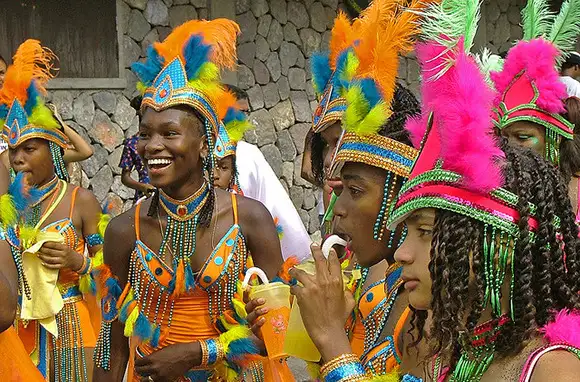
Dominica
Known as The Real Mas, the carnival in Dominica is billed as the most original in the Caribbean. You'll find all the traditional elements that you'd see in Trinidad and on neighboring islands, but in Dominica, one of the signature parade elements is the West African sensay costume. In the villages of St. Joseph and Grand Bay, the huge, shaggy head-to-toe costumes are made from strands of rope and colorful shredded fabric or straw. They're paired with massive horned masks and big boots with noisemakers on them. While most other carnivals end at midnight on the Tuesday before Ash Wednesday, this one rolls on into Wednesday, with Tewe Vaval, when people gather in the village of Dublanc for a mock funeral procession with drumming, dancing, and a bonfire to burn an effigy.
When: February 16–17, 2015
If You Go: The main carnival is in the capital city of Roseau. For a smaller, more intimate carnival experience, head to the villages of Portsmouth, Marigot, or Grand Bay.
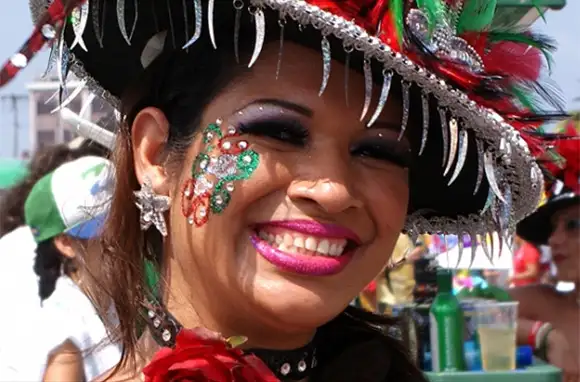
Aruba
Aruba's carnival in Oranjestad and San Nicolas is a terrifically colorful blend of cultural influences. Hear Antillean tumba music, the steel bands of the English Caribbean, Latin salsa, Dutch oompah, and grand marching bands. Flamboyant costume parades feature the same dancing and revelry you'll find in carnival celebrations on other islands. But when you throw in elaborate floats (think Macy's Thanksgiving Day Parade) and big brass bands whose members wear everything from Scottish plaids to African folk dress, this carnival seems more like a melting pot, deliciously diverse. There's a children's parade and an after-dark torchlight parade, as well as the J'ouvert morning "jump-up" and the ceremonial Burning of King Momo.
When: January 9–February 16, 2015
If You Go: See the colorful spirit of carnival anytime. Every Thursday night in San Nicolas, the Carubbian Festival captures the essence of carnival culture with live music, shows, food, stilt walkers, and a parade of glittery dancers wearing costumes from past carnivals.
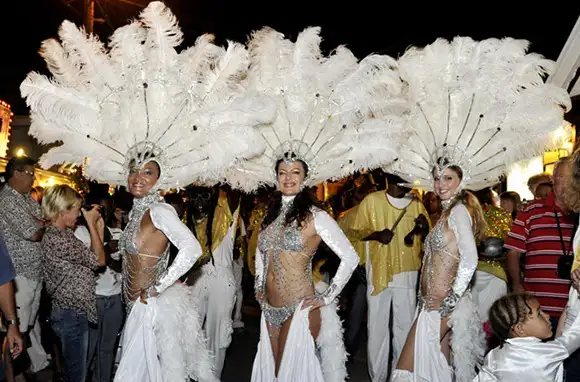
St. Martin/St. Maarten
This dual-country island hosts two different carnivals: one on the French side before Lent and the other on the Dutch side beginning Easter Monday. The French version brings disguised crowds to the streets for singing, dancing, confetti throwing, and parades. People follow "jump-up" parade buses with DJs and live music played by soca and calypso bands. At the larger Dutch-side celebration, a special Carnival Village is built each year in Phillipsburg as the hub for 100 food vendors, bands playing on outdoor stages, and other events. Partygoers fill the streets for pre-dawn dancing and grand masquerade parades, letting loose to the sound of drums and calypso beats.
When: January 30–February 18, 2015 (French side); April 16–May 4, 2015 (Dutch side)
If You Go: Don't miss the finale on the Dutch side: the Burning of King Momo, the king of craziness in Latin American folklore. Setting fire to the straw figure that embodies the spirit of the carnival is said to rid the island of its sins and bad luck, wiping the slate clean for good things to come.
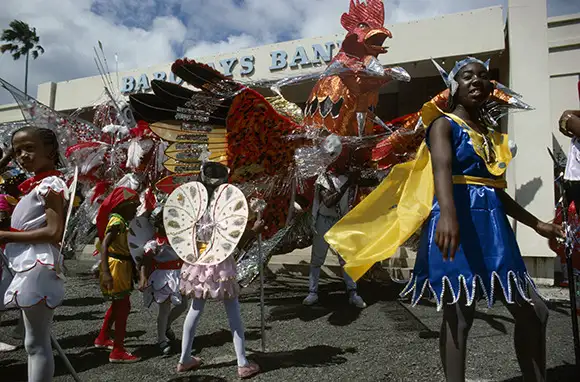
St. Lucia
St. Lucians call theirs the Caribbean's premiere boutique carnival. Smaller than Trinidad Carnival, the St. Lucia Carnival happens during summer, so it can draw the most renowned soca names from other regional carnivals that take place before Lent. Come for the masquerade parades, the Junior Carnival, and the steel-pan competition, when revved-up percussionists play for the coveted title of "Steel Pan Champions." At 4 a.m. on Carnival Monday, cover yourself with mud or body paint and join the traditional J'ouvert daybreak parade in Castries. In the Line Jam, people take to the streets in T-shirts and shorts to "jump up" to loud soca music.
When: July 15–21, 2015
If You Go: About a month before the main carnival, calypso tents begin to stage regular soca and calypso shows, until the competition rounds begin and finalists are chosen.
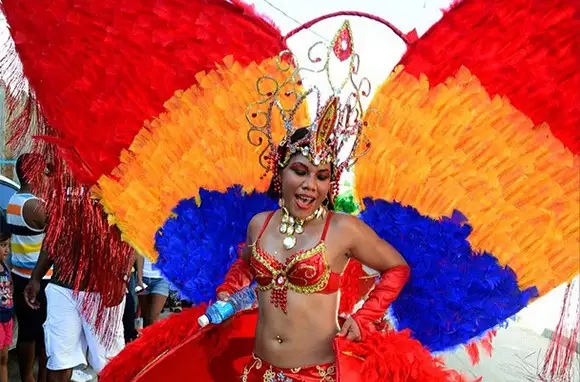
Belize
On the island of Ambergris Caye, the city of San Pedro throws one of the biggest carnivals in Belize. Carnaval de San Pedro, a pre-Lent party that's more playful than glamorous or scandalous, follows many of the traditions of the carnival in Cadiz, Spain, where some of the town's early residents came from. This is a carnival with parades and dancing that are infused with humor. Expect to see funny costumes, social and political criticism disguised as comedy, and comedic comparsa singing groups. Comparsa events are some of the town's favorites, especially the em>comparsa group made up of highly regarded men from the community who dress like women, in outlandish costumes, and dance in the streets for the top prize.
When: February 7–18, 2015
If You Go: At the end of the carnival, revelers hit the street to paint each other with water-based paints or water mixed with raw eggs. It's a wild mess. If you don't want to be painted, stay in your hotel room.
You Might Also Like:
We hand-pick everything we recommend and select items through testing and reviews. Some products are sent to us free of charge with no incentive to offer a favorable review. We offer our unbiased opinions and do not accept compensation to review products. All items are in stock and prices are accurate at the time of publication. If you buy something through our links, we may earn a commission.
Related
Top Fares From
Today's Top Travel Deals
Brought to you by ShermansTravel
Kenya: 14-Night Tour, Incl. Tanzania &...
smarTours
 vacation
$7125+
vacation
$7125+
7-Night Caribbean Round-Trip Cruise From Orlando:...
Norwegian Cruise Line
 cruise
$739+
cruise
$739+
Ohio: Daily Car Rentals from Cincinnati
85OFF.com
 Car Rental
$19+
Car Rental
$19+
